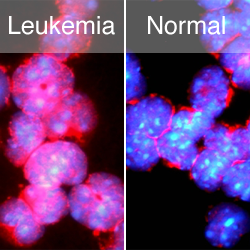 Acute myelogenous leukemia (AML) is one of the most common types of leukemia—a cancer of the bone marrow and blood—in adults, affecting about 13,300 women and men in the United States annually. The disease is also diagnosed in hundreds of children in this country each year.
Acute myelogenous leukemia (AML) is one of the most common types of leukemia—a cancer of the bone marrow and blood—in adults, affecting about 13,300 women and men in the United States annually. The disease is also diagnosed in hundreds of children in this country each year.
Sadly, 60-70 percent of adults and about 40 percent of children in remission from AML will have a relapse. Scientists now believe that the cause is leukemia stem cells—endlessly self-renewing cancer cells that are resistant to conventional cancer treatments.
A study in mice conducted by HSCI Cancer Program co-leader Scott Armstrong, MD, PhD, of Children’s Hospital Boston and Dana-Farber Cancer Institute, and his team found that leukemia stem cells cannot develop and thrive without a particular cell-signaling pathway, known as the Wnt/beta-catenin pathway.
This discovery suggests that selectively targeting this pathway could prevent the growth of these stem cells and, thus, AML. “Targeting the Wnt/beta-catenin pathway, which is required for the development of leukemia stem cells in AML, may present a new therapeutic opportunity in this disease,” says Armstrong. The study was published online in March in the journal Science.
Among the steps researchers took to confirm the role of beta-catenin in leukemia stem cell development and survival was to treat mice injected with leukemia stem cells with indomethacin, a drug that blocks the beta-catenin pathway. In mice given the drug, the number of leukemia stem cells dwindled. The drug also reduced the number of leukemia stem cells in mice with fully developed leukemia.
Before these findings can be applied in the clinic, better beta-catenin inhibitors are needed, since it is not known if indomethacin can be given to people with leukemia in high enough doses to wipe out leukemia stem cells without having toxic effects, Armstrong says.
The next step for researchers is to determine why leukemia stem cells need the beta-catenin pathway to survive. “Any step along this pathway is a potential therapeutic target,” says Armstrong.
Photo: These images show (left to right): high-level beta-catenin pathway activity (red) in leukemia stem cells, and minimal beta-catenin pathway activity in normal, immature white blood cells. (Credit: Scott Armstrong)
